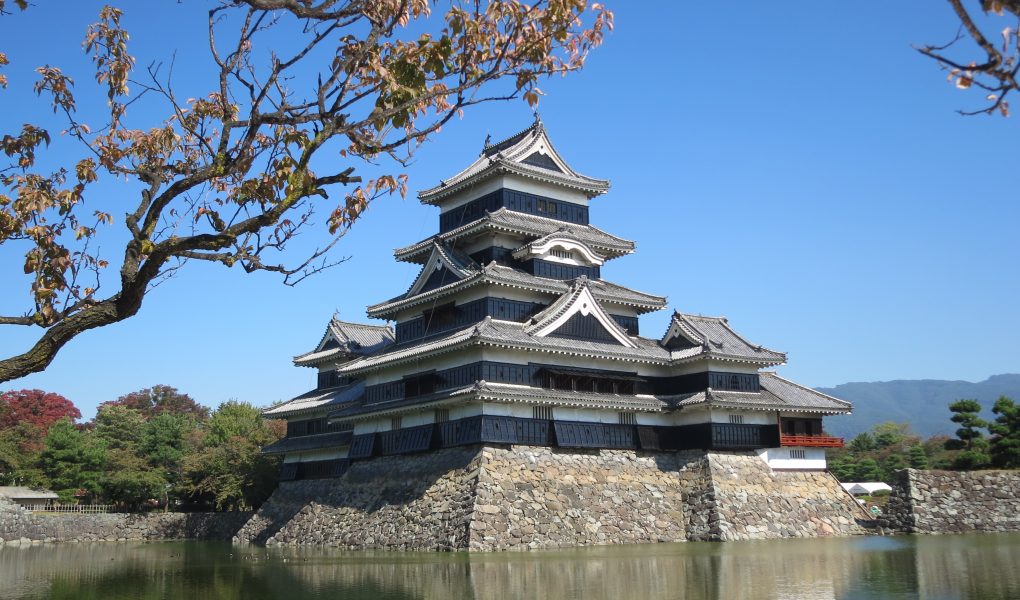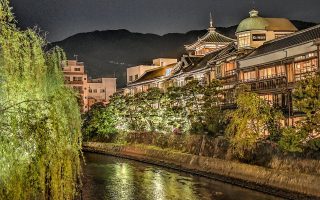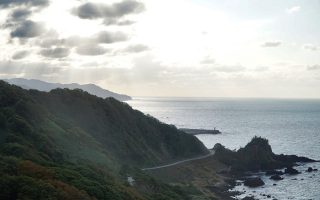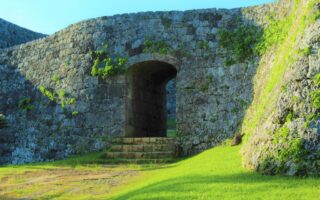Matsumoto castle is one of Japans most unique and beautiful castles. The castle complex is designated both as national treasures and cultural treasure. Matsumoto Castle together with Himeji Castle and Kumamoto Castle are considered the 3 most beautiful (and famous) castles in the country. It is also one of only 12 surviving original castles in Japan.
“The Crow Castle” is the nickname for Matsumoto Castle. The castle already gained this less flattering name several hundred years ago due to it’s black painted exterior and wing-like roof. The dark appearance surely makes for an intimidating and unwelcoming look when you approach the structure. But don’t get scared – Matsumoto Castle is one of the most authentic and best kept castles in all of Japan. Where many historic castles in Japan have been modernized or rebuilt with reinforced concrete intereriors, Matsumoto castle is original – all wooden structures.
Structures
Matsumoto Castle is a complicated structure. It consists of several building which have been added during different time periods. The Keep, the Northern Tower and the passage between were constructed during wartimes (Warring States period). The Moon Viewing Tower and Southern Wing were built later, during peacetimes. Read more about those periods in the history section further down the page.
Wartime vs. Peacetime
It’s interesting to see the difference between the buildings constructed during wartimes and peace times.
The Keep and Northern Tower have hatches for firing guns as well as openings along the first floor, from which stones etc. can be dropped on invaders. The Moon Viewing Room and the Southern Wing which connects it to the keep are built later. They have no gun hatches or openings for dropping stones. The name “Moon Viewing Tower” also suggests that it was constructed at a time where pleasure was more important than protection.
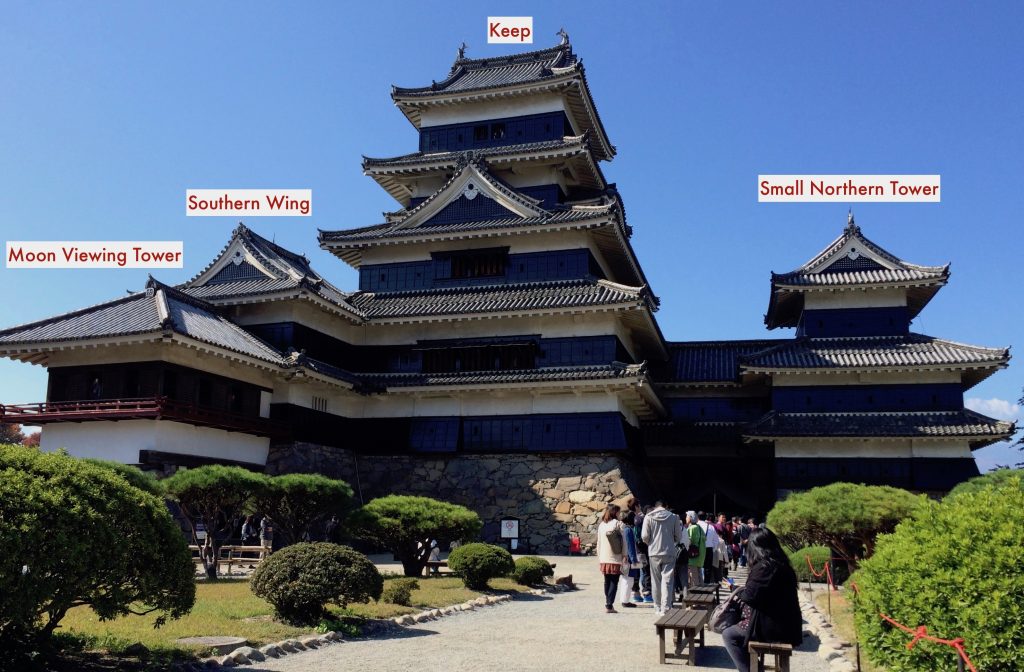
History
Matsumoto castle has a complex history and a long list of rulers. I have attempted to shorten it down to a readable, yet meaningful summary without too many names.
Matsumoto Castle during the “Age of Warring States”
In 1504 a fortification, known as Fukashi Castle was built near present day Matsumoto Castle. At the time, Japan was in the so-called “Age of Warring States” period.
Age of warring states a period of about 100 years (1467-1568) where the Shogun had effecticly lost influence and local lords took over the power and started fighting each other.
With the wars raging everywhere, a prominent feudal lord named Takaeda Shingen seized Fukashi Castle as part of a larger invasive campaign. The Takaeda clan renovated the castle and kept it until the entire clan was defeated and destroyed in 1582. Different clans ruled the Matsumoto area in the following years. During those years Fukashi was renamed to Matsumoto and the castle town was built.
In 1593 the construction of the castles current main keep was ongoing.
Matsumoto Castle during the “Edo Period”
After the Tokugawa clan took control with Japan in 1603 the country entered a time of peace. The Tokugawa shogunate created the Matsumoto domain which was ruled by many different lord over time.
In 1633 the Moon Watching Tower was added to the structure. It was also during this peace time that the areas around the castle were developed.
Matsumoto Castle after the “Meiji Restoration”
After the Meiji Restoration the land of Matsumoto Castle was given to the emperor. Like most other feudal castles, Matsumoto Castle was auctioned off as part of the abolishment of the feudal system. Many parts of the complex was torn down. It was rumored that the castles keep was going to be torn down too. The potential destruction of the keep upset a number of residents of Matsumoto, who started working to save the structure from destruction. Luckily they were successful as the city government decided to acquire the facility.
Fun fact: the castle grounds were used for experimental fruit growing and agriculture in the late 1800’s
In 1902 the castle grounds were turned into a schoolyard as a nearby school needed more space. Following this, the first of two major renovations were undertaken in 1903. In 1930 the school was relocated. There was a plan to turn the area into a park, but the thread of a large war stopped those plans. The park project was taken up again in 1948, and the second renovation followed in 1950.
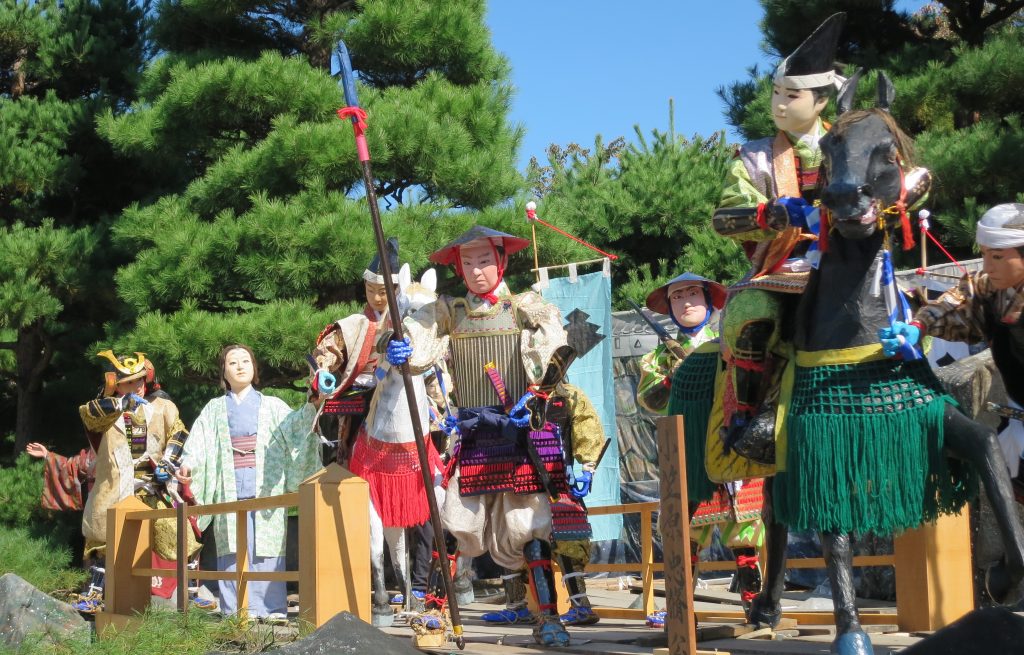
Planning your visit
Matsumoto Castle is one of those attractions you simply shouldn’t miss if you are in the region. It’s a well preserved piece of history like few others in Japan. If you have to visit one Japanese castle during your stay, then Matsumoto Castle is highly recommended. It might not be quite as majestic as Himeji Castle, but it is much more authentic. Matsumoto Castle also hosts quite a lot of events, so check out their event calendar if you want to add a little to your experience.
| Hours | 8:30 – 17:00 all days of the week. Last admission is 30 minutes before closing time. |
| Entrance fee | Adults: ¥610 Students: ¥300 |
Getting there
By train from Tokyo: take the Tohoku or Hokuriku Shinkansen train to Nagano Station (1h20min). From Nagano take the JR Shinano or Shinonoi line to Matsumoto Station (50min). The trip is covered by the Japan Rail Pass.
By train from Kyoto: take the Tokaido-Sanyo Shinkansen train to Nagoya Station (35min). At Nagoya station take the JR Shinano Line to Matsumoto Station (2h). The trip is covered by the Japan Rail Pass.
From Matsumoto Station it’s a 15 minute walk to the castle. It’s possible to shorten the walk slightly by continuing on the Oito Line 1 stop from Kumamoto Station to Kita-Matsumoto Station wherefrom it’s a 10 minute walk to the castle.

